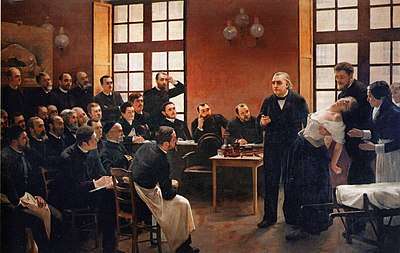Marie "Blanche" Wittmann

Marie "Blanche" Wittmann (1859–1913) known as the Queen of Hysterics, was the most famous hysteria patient of Jean-Martin Charcot at the Salpêtrière Hospital.[2][3]
It is not quite certain what her real name was, as she is referred to in the relevant literature as Marie, W... W, Wit, Witt and as Blanche Witt.[4][3] However, there is a record of a Marie Wittman, born on 15 April 1859 in Paris, who came to the hospital on May 6, 1877, suffering from epilepsy; this is notably similar to a publication saying that “W ... Marie, seamstress ... entered the service of M. Charcot on May 5, 1877”.[4]
In any case, the woman known as the Queen of Hysterics went into hysterics under hypnosis by Jean-Martin Charcot at weekly stage performances.[5][6] Sigmund Freud was one of those who witnessed her hysterics.[2]
After Charcot's death in 1893, she no longer suffered from convulsions[2] and became an aid in the photography laboratory, then one of the first victims of X-rays during the beginnings of radiology at La Salpêtrière. Later, she began working for Marie Curie two years after Charcot died; and as a consequence of her exposure to radiation, Wittman had to have both her legs and her left arm amputated.[7]
Three notebooks of Wittmann's, the Yellow, the Black, and the Red, were discovered twenty-five years after Wittmann's death, and influenced Per Olov Enquist's novel The Book about Blanche and Marie.[7] In that novel, published in 2004, she appears as a character, along with Marie Curie and Charcot (English translation, 2006, ISBN 1-58567-668-3).
See also
References
- ↑ The identities of each of the thirty separate individuals that are represented in this composite (1887) presentation painting by Pierre Aristide, André Brouillet (1857–1914) have been clearly identified at p.471 of Harris, J.C., "A Clinical Lesson at the Salpêtrière", Archives of General Psychiatry, Vol.62, No.5, (May 2005), pp.470–472.
- 1 2 3 Esther Inglis-Arkell (August 14, 2014). "Meet the "Queen of Hysterics" Who Was Freud's Early Muse". io9. Retrieved 2017-08-26.
- 1 2 "BLANCHE – IMAGINARNA DŽUNGLA". Atelje Galerija. Retrieved 2017-08-26.
- 1 2 Carlos S. Alvarado (2009). "NINETEENTH-CENTURY HYSTERIA AND HYPNOSIS: A HISTORICAL NOTE ON BLANCHE WITTMANN" (PDF). Australian Journal of Clinical and Experimental Hypnosis, Vol. 37, No. 1, pgs. 21–36. Retrieved 2017-08-26.
- ↑ Reviewed by Arifa Akbar. "Medical Muses: Hysteria in Nineteenth Century Paris, By Asti Hustvedt". The Independent. Retrieved 2017-08-27.
- ↑ In addition to producing phenomena for Jean-Martin Charcot, Wittmann performed for others such as Gilbert Ballet, Alfred Binet, Charles Féré, Jules Janet, and Paul Richer.
- 1 2 Binding, Paul. "The Story of Blanche and Marie by Per Olov Enquist, trs Tiina Nunnally". The Independent. Retrieved 2017-08-27.
Further reading
- Medical Muses: Hysteria in Nineteenth-Century Paris, by Asti Hustvedt (2011)
- Alvarado, C., "Nineteenth-Century Hysteria and Hypnosis: A Historical Note on Blanche Wittmann", Australian Journal of Clinical and Experimental Hypnosis, Vol.37, No.1, (May 2009), pp.21–36.